As a rule, the aim of dyeing fabric is to infuse it with colour. But resist-dyeing techniques work counterintuitively. They’re all about blocking the dye from reaching certain parts of the fabric. Perhaps the best known example of this is tie-dye, where knots in the material shield parts of it from the colour. Then there is batik.
This centuries-old method uses wax to create patterns on fabric which the dye will not permeate. Said to date back over 1,500 years and used by various cultures, it’s most associated with the Indonesian island of Java. UNESCO has even recognised Indonesian batik as a Masterpiece of Oral and Intangible Heritage of Humanity.
So, precisely what is batik? And what is batik cloth? We’ve got all the material facts, so read on to find out more.
What is Batik?

Creating batik fabric (Credit: AzmanL via Getty Images)
The word ‘batik’ probably originates from the Javanese word ‘tik,’ which means to dot, reflecting the technique of dotting wax on fabric to create patterns. The wax can be applied with a tool called a tjanting, which allows for fine control for detailed designs, or with a copper stamp called a cap, which is used for repeating patterns.
Once the wax hardens, the fabric is then immersed in dye. The wax acts as a dye-resist agent; it prevents the dye from penetrating the fabric where it’s applied, thus preserving the original colour of these areas. This technique can be repeated to add multiple colours, with each layer of wax and dye adding to the complexity and vibrancy of the design.
There is also a second answer to the question ‘what is batik.’ Because it’s both a verb and a noun. In other words, it’s the name of both the technique and the patterned fabric it creates.
What is Batik Cloth?

Printed batik cloth (Credit: Edwin Tan via Getty Images)
Typically, the answer to ‘what is batik fabric’ is that the base cloth is cotton or silk. Both materials are known for their capacity to take on fine, intricate designs created by the batik process. The quality and type of fabric directly influence the intricacy and the aesthetic quality of the batik design. Cotton, being more absorbent, allows for sharper lines and more resilient colours, making it a popular choice among batik artists.
Another aspect when exploring ‘what is batik cloth’ is the diversity in its applications, from traditional garments such as the Javanese kebaya to more contemporary fashion items and home décor. Each piece of batik fabric reflects the artistic expression of the maker, characterised by unique patterns that often carry symbolic meanings, with certain motifs used exclusively in specific cultural and ritual contexts.
Batik Painting Methods

Batik painting using a canting (Credit: Harry Allan Papendang via Getty Images)
There are two main methods of batik painting. The more traditional Javanese form of the art is batik tulis. Tulis literally means ‘written’ and refers to batik that is hand drawn. This highly intensive process uses a tool called a canting, a pen-like instrument that dispenses hot wax. Batik tulis is highly valued due to its intricate detail and the skill required, making each piece unique.
By contrast, batik cap uses a copper stamp (cap) to apply wax to the fabric. The stamp allows for repeating patterns to be made more quickly and uniformly than the hand-drawn method. Batik cap is more commercially viable due to its efficiency in producing larger quantities of fabric in a consistent pattern.
Modern Batik Art

A vibrant batik quilt (Credit: JTGrafix via Getty Images)
In addition to traditional techniques, contemporary batik has evolved, incorporating new materials and methods. Modern batik artists experiment with different types of dyes and waxes and sometimes utilise tools like brushes or stamps for wax application, expanding the possibilities for batik painting. These innovations have invited a broader audience to appreciate and engage with batik, making it a versatile and appealing form of artistic expression.
Cultural Significance

The cultural significance of batik art (Credit: wulingyun via Getty Images)
The cultural significance of batik extends beyond its beauty. In Indonesia, for instance, batik is not merely a craft but is woven into the fabric of daily life; it’s worn in formal attire, used in weddings, and serves as a hieroglyphic language through its motifs, each conveying specific messages and cultural values.
Summarising Batik Art

The creation of batik art (Credit: Photo by Prayudi Hartono via Getty Images)
There are various aspects to answering ‘what is batik.’ It’s a confluence of art, science, and culture. It encapsulates a comprehensive methodology which includes the chemistry of dye making, the physics of colour interaction, and the artistic vision in pattern creation. As it continues to evolve, this unique art form embraces new technologies and artistic concepts, ensuring its place in the contemporary textile industry while maintaining its cultural roots.












